Comparison of CuCl/NaY and CuCl/AC Process Performance Using a Vacuum Pressure Swing Adsorption Simulation
Abstract
1. Introduction
2. Experimental Section
2.1. Adsorbent Materials
2.2. Adsorption Equilibrium Isotherms
2.3. Fixed-Bed Breakthrough Measurement
2.4. Simulation Method
3. Computational Analysis
3.1. Mass, Energy, and Momentum Balance Model
3.2. Performance Parameters for the Evaluation of VPSA Cycles
3.3. Fixed-Bed Breakthrough Simulation
3.4. Simulation of the VPSA Process
4. Results and Discussion
4.1. Concentration and Adsorption Capacity at the End of Each Step
4.2. Computational Results
5. Conclusions
Author Contributions
Funding
Institutional Review Board Statement
Informed Consent Statement
Data Availability Statement
Conflicts of Interest
Nomenclature
| Dax | axial dispersion coefficient (m2 s −1) |
| ci | gas-phase concentration of component i (mol m−3) |
| Cpa,i | specific heat capacity of the adsorbed phase of component i (kJ·kmol−1·K−1) |
| Cps | specific heat capacity of the adsorbent (kJ·kg−1·K−1) |
| Cpw | specific heat capacity of the bed wall (kJ·kg−1·K−1) |
| Cvg | specific gas-phase heat capacity at the constant volume (kJ·kmol−1·K−1) |
| Db | bed diameter (m) |
| Dm,i | molecular diffusion coefficient of component i (m2·s−1) |
| Ecomp | compressor energy consumption (kW) |
| Epump | energy consumption of vacuum pumps (kW) |
| F | molar flow rate (mol·s−1) |
| HTCap | gas−solid heat transfer coefficient (W·m−2·K−1) |
| Hw | gas–wall heat transfer coefficient (W·m−2·K−1) |
| kg | gas–phase thermal conductivity (W·m−1·K−1) |
| ks | solid thermal conductivity (W·m−1·K−1) |
| kw | thermal conductivity of the bed wall (W·m−1·K−1) |
| M | molecular weight (kg mol−1) |
| P | pressure (bar) |
| qi | adsorbed phase concentration with bulk component i (kmol kg−1) |
| rp | adsorbent particle radius (m) |
| t | time (s) |
| T0 | inner temperature of the bed wall (K) |
| Tamb | ambient temperature (K) |
| Tg | gas–phase temperature (K) |
| Ts | solid temperature (K) |
| Tw | bed wall temperature (K) |
| wi | adsorbed phase concentration of component i (mol·kg−1) |
| wi* | adsorbed phase concentration in equilibrium with bulk component i (mol·kg−1) |
| Wt | thickness of the bed wall (m) |
| z | axial coordinate (m) |
| ΔHi | isosteric heat of adsorption of component i (kJ·mol−1) |
| εb | bed void fraction |
| ψ | shape factor |
| μ | gas viscosity (kg m−1 s−1) |
| νg | gas velocity (m s−1) |
| ρg | gas–phase molar density (mol·m−3) |
| ρs | adsorbent density (kg·m−3) |
| ρw | density of the bed wall (kg·m−3) |
References
- Evans, A.; Luebke, R.; Petit, C. The Use of Metal–Organic Frameworks for CO Purification. J. Mater. Chem. A 2018, 6, 10570–10594. [Google Scholar] [CrossRef]
- Mesters, C. A Selection of Recent Advances in C1 Chemistry. Annu. Rev. Chem. Biomol. Eng. 2016, 7, 223–238. [Google Scholar] [CrossRef] [PubMed]
- Martinelli, M.; Gnanamani, M.K.; LeViness, S.; Jacobs, G.; Shafer, W.D. An Overview of Fischer-Tropsch Synthesis: XtL Processes, Catalysts and Reactors. Appl. Catal. Gen. 2020, 608, 117740. [Google Scholar] [CrossRef]
- Heymans, N.; Alban, B.; Moreau, S.; De Weireld, G. Experimental and Theoretical Study of the Adsorption of Pure Molecules and Binary Systems Containing Methane, Carbon Monoxide, Carbon Dioxide and Nitrogen. Application to the Syngas Generation. Chem. Eng. Sci. 2011, 66, 3850–3858. [Google Scholar] [CrossRef]
- Karousos, D.S.; Theodorakopoulos, G.V.; Chiesa, F.; Barbe, S.; Bouroushian, M.; Favvas, E.P. CO2/CH4 and CO2/CO Selective Pebax-1657 Based Composite Hollow Fiber Membranes Prepared by a Novel Dip-Coating Technique. Separations 2025, 12, 3. [Google Scholar] [CrossRef]
- Ramírez-Santos, Á.A.; Castel, C.; Favre, E. A Review of Gas Separation Technologies within Emission Reduction Programs in the Iron and Steel Sector: Current Application and Development Perspectives. Sep. Purif. Technol. 2018, 194, 425–442. [Google Scholar] [CrossRef]
- Oh, H.; Beum, H.T.; Yoon, Y.-S.; Kim, J.; Han, Y.; Kim, J.; Lee, I.-B.; Lee, S.-Y.; Han, S.S. Experiment and Modeling of Adsorption of CO from Blast Furnace Gas onto CuCl/Boehmite. Ind. Eng. Chem. Res. 2020, 59, 12176–12185. [Google Scholar] [CrossRef]
- Tao, L.R.; You, Y.Y.; Liu, X.J. Numerical Studies of CO Separation and Enrichment from Blast Furnace Gas by Using a CuCl/Y Fixed Bed. Ironmak. Steelmak. 2021, 48, 1187–1199. [Google Scholar] [CrossRef]
- Dutta, N.N.; Patil, G.S. Developments in CO Separation. Gas Sep. Purif. 1995, 9, 277–283. [Google Scholar] [CrossRef]
- Kang, Y.; Liu, Y.; Liu, W.; Li, Y.; Sun, N.; Zhang, Q.; Li, Z.; Yang, X. Effect of Vacuum Process on Enrichment of Low-Concentration Coal Mine Methane by Adsorption. Separations 2025, 12, 56. [Google Scholar] [CrossRef]
- Zhu, L.; Tu, J.; Shi, Y. Separation of CO-CO2-N2 Gas Mixture for High-Purity CO by Pressure Swing Adsorption. Gas Sep. Purif. 1991, 5, 173–176. [Google Scholar] [CrossRef]
- Chen, Y.; Ning, P.; Xie, Y.; Chen, Y.; Sun, H.; Liu, Z. Pilot-Scale Experiment for Purification of CO from Industrial Tail Gases by Pressure Swing Adsorption. Chin. J. Chem. Eng. 2008, 16, 715–721. [Google Scholar] [CrossRef]
- Gao, F.; Wang, Y.; Wang, S. Selective Adsorption of CO on CuCl/Y Adsorbent Prepared Using CuCl2 as Precursor: Equilibrium and Thermodynamics. Chem. Eng. J. 2016, 290, 418–427. [Google Scholar] [CrossRef]
- Ko, K.-J.; Kim, H.; Cho, Y.-H.; Lee, H.; Kim, K.-M.; Lee, C.-H. Overview of Carbon Monoxide Adsorption Performance of Pristine and Modified Adsorbents. J. Chem. Eng. Data 2022, 67, 1599–1616. [Google Scholar] [CrossRef]
- Gao, F.; Wang, S.; Wang, W.; Duan, J.; Dong, J.; Chen, G. Adsorption Separation of CO from Syngas with CuCl@AC Adsorbent by a VPSA Process. RSC Adv. 2018, 8, 39362–39370. [Google Scholar] [CrossRef]
- Li, S.; Yang, H.; Zhang, D. Enrichment of CO from Syngas with Cu(I)Y Adsorbent by Five-Bed VPSA. Front. Chem. Sci. Eng. 2013, 7, 472–481. [Google Scholar] [CrossRef]
- Zhou, Y.; Shen, Y.; Fu, Q.; Zhang, D. CO Enrichment from Low-Concentration Syngas by a Layered-Bed VPSA Process. Ind. Eng. Chem. Res. 2017, 56, 6741–6754. [Google Scholar] [CrossRef]
- Oh, H.; Beum, H.T.; Lee, S.-Y.; Kim, J.; Kim, J.; Yun, Y.; Han, S.S. Bed Configurations in CO Vacuum Pressure Swing Adsorption Process for Basic Oxygen Furnace Gas Utilization: Experiment, Simulation, and Techno-Economic Analysis. Chem. Eng. J. 2023, 454, 140432. [Google Scholar] [CrossRef]
- Li, C.; Wang, J.; Wang, Z.; Dong, J.; Shi, Q. Understanding the Vacuum Autoreduction Behavior of Cu Species in CuCl/NaY Adsorbent for CO/N2 Separation. Microporous Mesoporous Mater. 2024, 365, 112904. [Google Scholar] [CrossRef]
- Yuan, M.; Liu, T.; Shi, Q.; Dong, J. Understanding the KOH Activation Mechanism of Zeolitic Imidazolate Framework-Derived Porous Carbon and Their Corresponding Furfural/Acetic Acid Adsorption Separation Performance. Chem. Eng. J. 2022, 428, 132016. [Google Scholar] [CrossRef]
- Cui, Y.; Su, W.; Xing, Y.; Hao, L.; Sun, Y.; Cai, Y. Experimental and Simulation Evaluation of CO2/CO Separation under Different Component Ratios in Blast Furnace Gas on Zeolites. Chem. Eng. J. 2023, 472, 144579. [Google Scholar] [CrossRef]
- Haghpanah, R.; Majumder, A.; Nilam, R.; Rajendran, A.; Farooq, S.; Karimi, I.A.; Amanullah, M. Multiobjective Optimization of a Four-Step Adsorption Process for Postcombustion CO2 Capture Via Finite Volume Simulation. Ind. Eng. Chem. Res. 2013, 52, 4249–4265. [Google Scholar] [CrossRef]
- Ergun, S. Fluid Flow through Packed Columns. Chem. Eng. Prog. 1952, 48, 89–94. [Google Scholar]
- Yu, C.; Guo, Z.; Yang, L.; Cui, J.; Chen, S.; Bo, Y.; Suo, X.; Gong, Q.; Zhang, S.; Cui, X.; et al. A Robust Metal-Organic Framework with Scalable Synthesis and Optimal Adsorption and Desorption for Energy-Efficient Ethylene Purification. Angew. Chem. Int. Ed. 2023, 62, e202218027. [Google Scholar] [CrossRef]

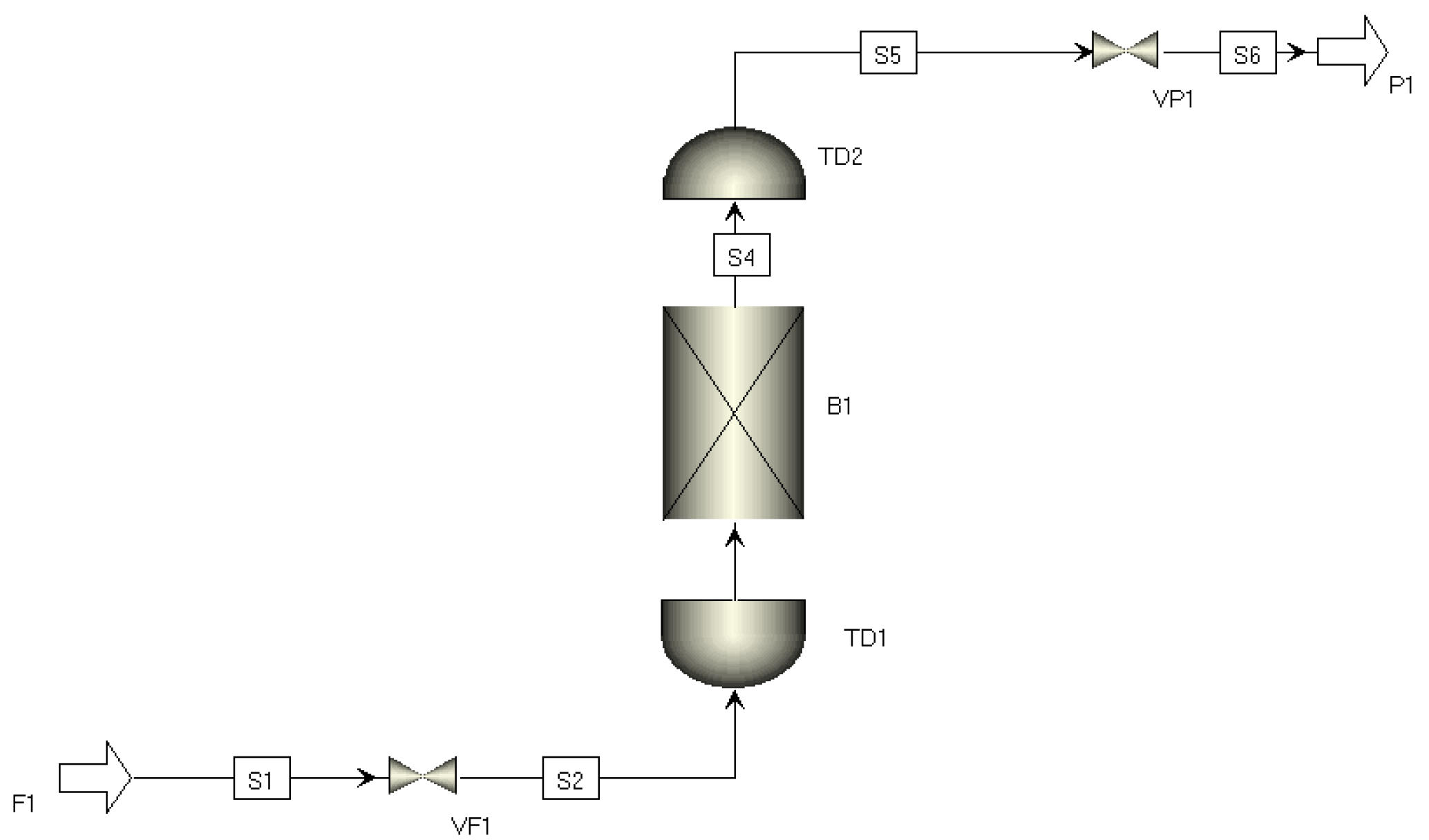
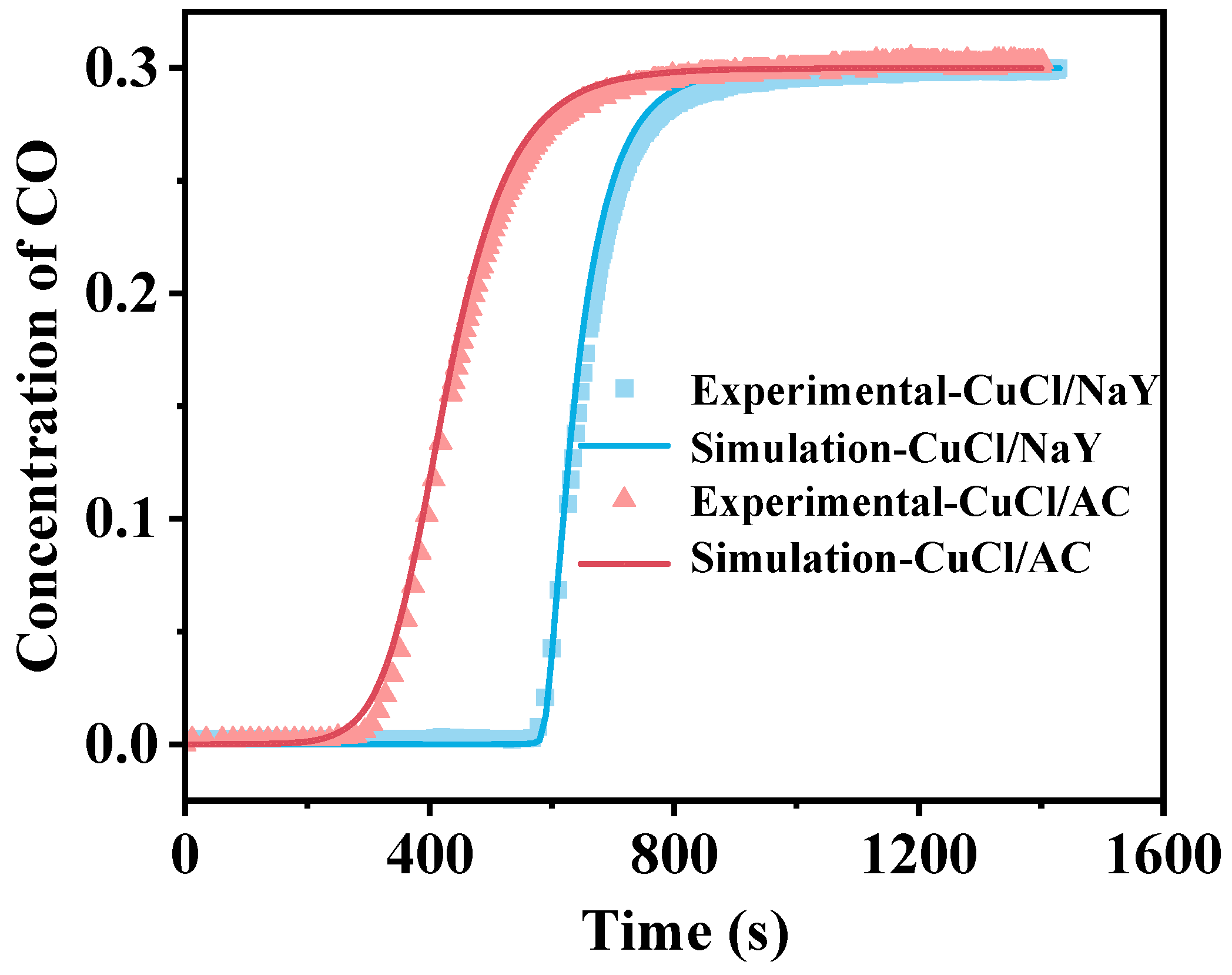


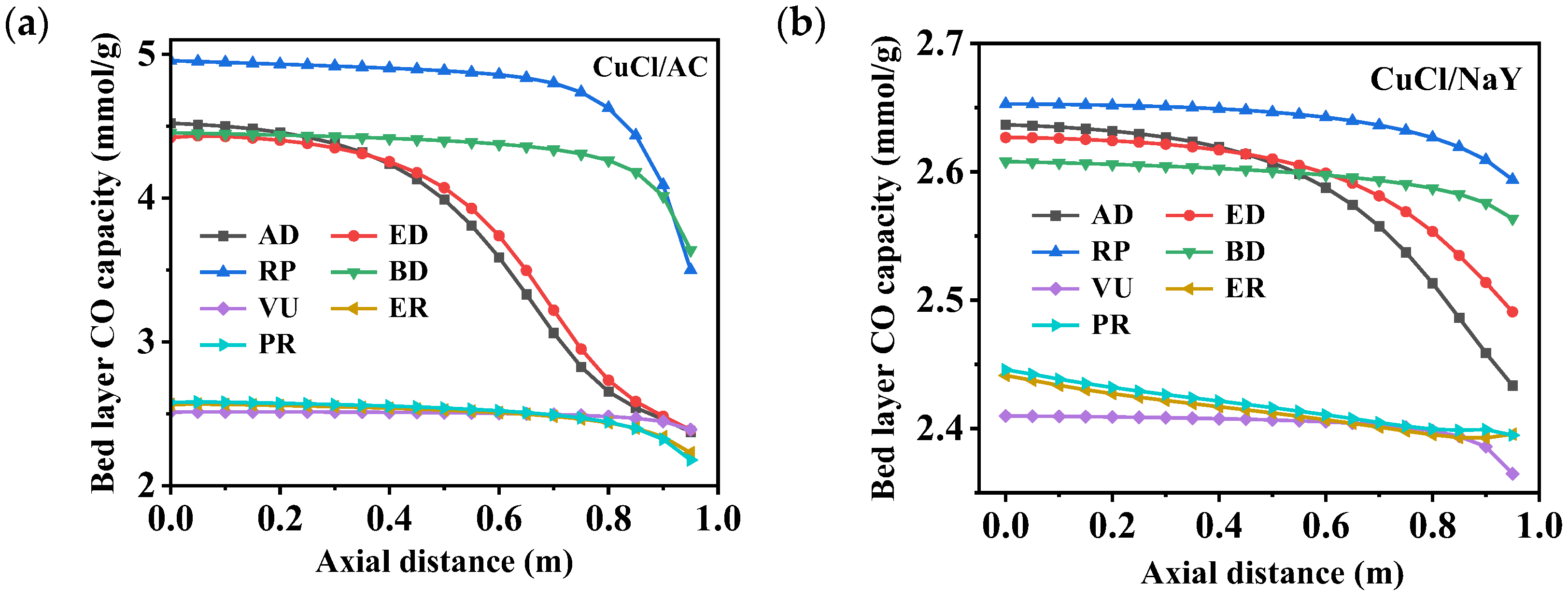
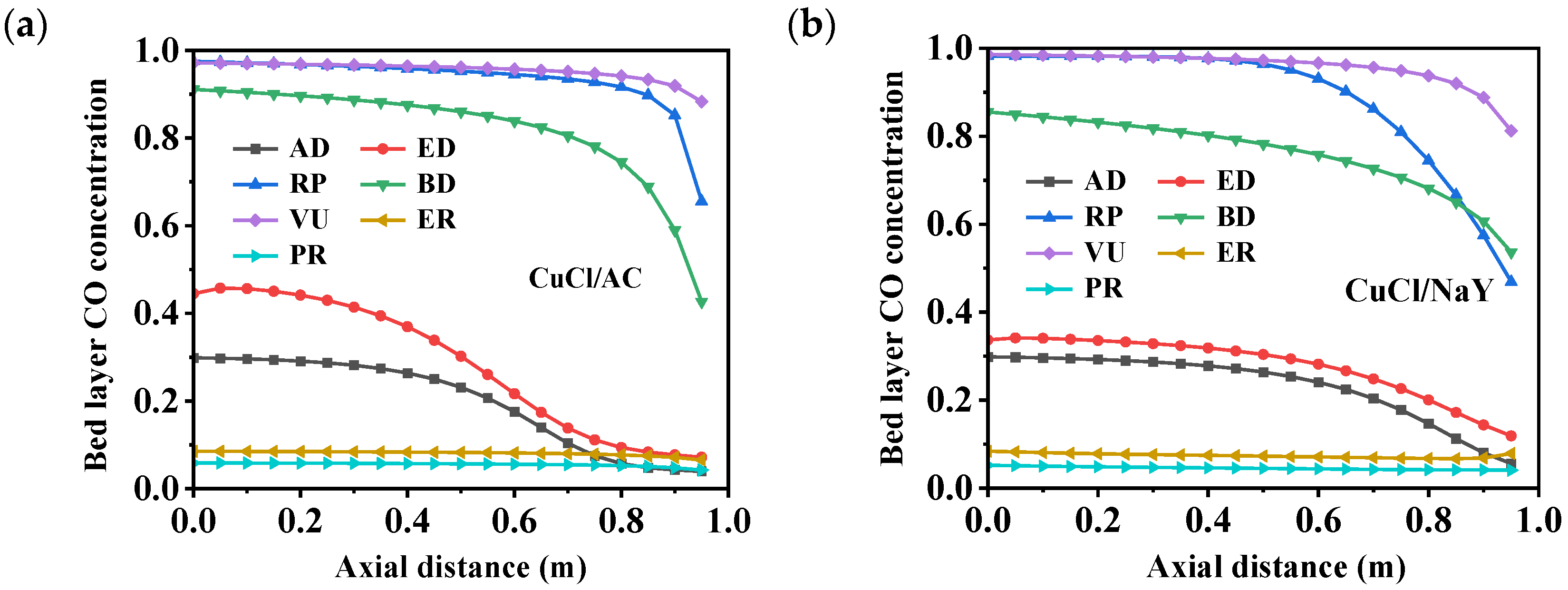
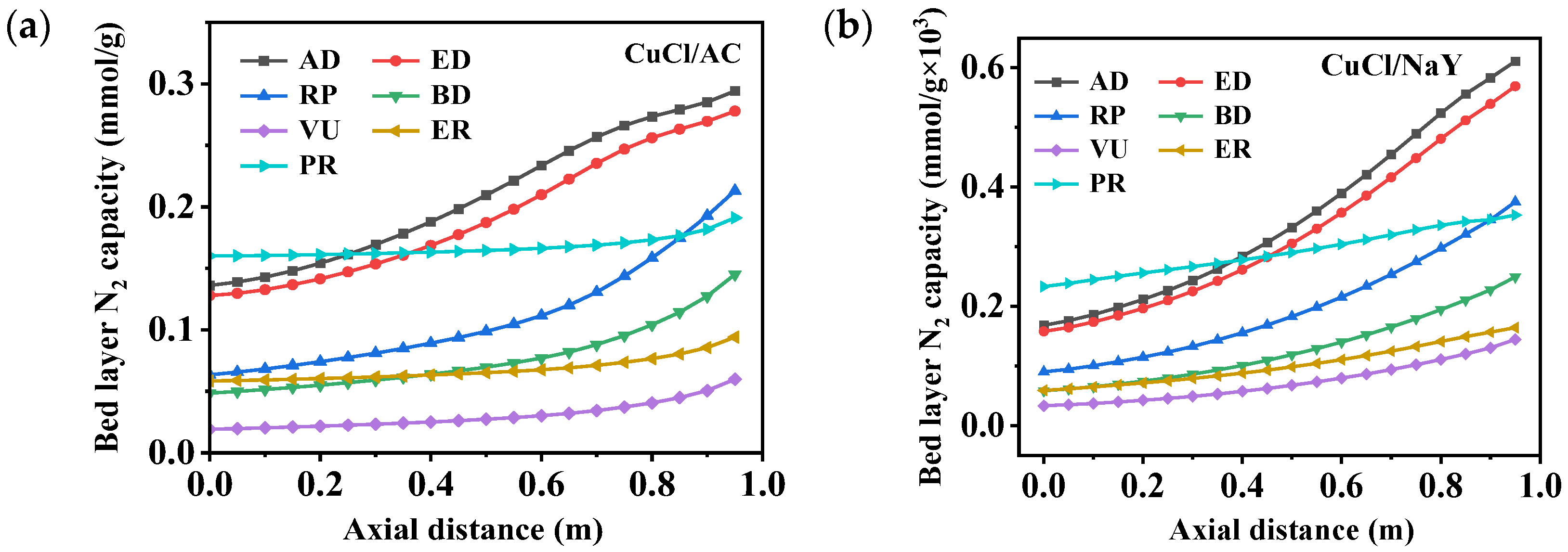
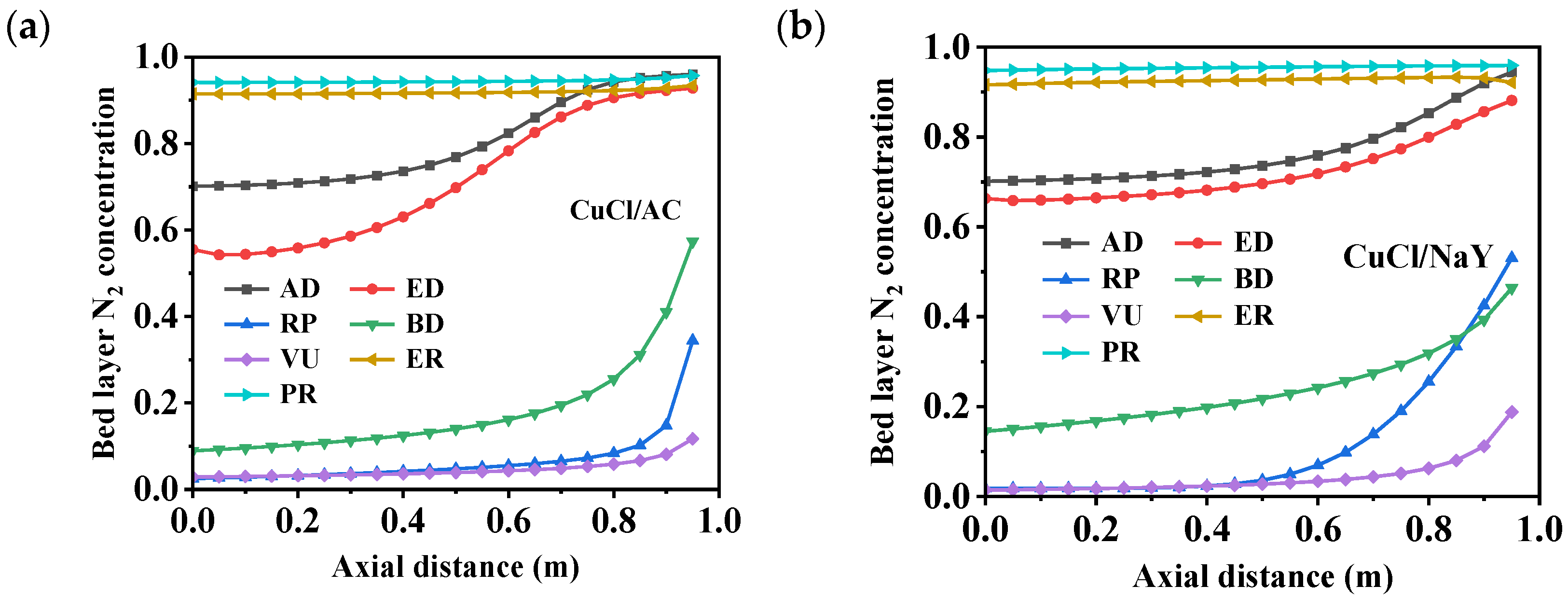
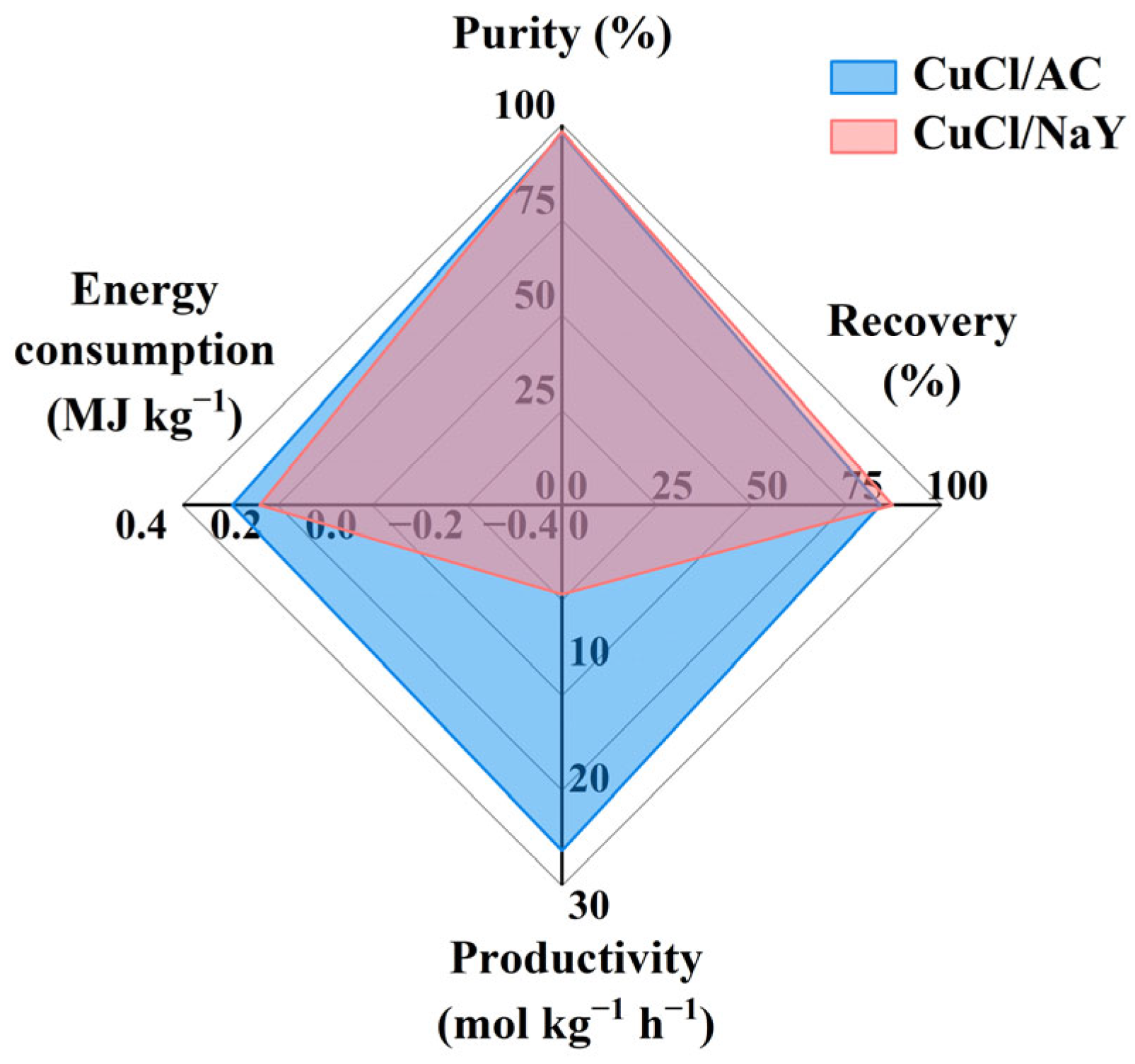
| Isotherm Parameters | CuCl/NaY | CuCl/AC | ||
|---|---|---|---|---|
| CO | N2 | CO | N2 | |
| IP1 | 2.82 | 7.34 × 10−5 | 0.02 | 8.51 × 10−5 |
| IP2 | 2130.99 | 0.35 | 3.76 | 0.04 |
| IP3 | 0.02 | 0 | 5.99 × 10−5 | 4.80 × 10−4 |
| IP4 | 17.72 | 0 | −0.02 | 6.20 |
| Time | CuCl/AC | 60 | 180 | 60 | 180 | 60 | 180 | 60 | 180 | 60 | 180 |
| CuCl/NaY | 40 | 160 | 40 | 160 | 40 | 160 | 40 | 160 | 40 | 160 | |
| Bed1 | AD | AD | ED | RP | RP | BD | VU | VU | ER | PR | |
| Bed2 | ER | PR | AD | AD | ED | RP | RP | BD | VU | VU | |
| Bed3 | VU | VU | ER | PR | AD | AD | ED | RP | RP | BD | |
| Bed4 | RP | BD | VU | VU | ER | PR | AD | AD | ED | RP | |
| Bed5 | ED | RP | RP | BD | VU | VU | ER | PR | AD | AD | |
| CuCl/NaY | CuCl/AC | |||
|---|---|---|---|---|
| Parameter | Unit | Value | Value | Description |
| Hb | m | 1 | 1 | Height of the adsorbent layer |
| Wt | m | 0.01 | 0.01 | Bed wall thickness |
| Db | m | 0.25 | 0.25 | Internal diameter of the adsorbent layer |
| Ei | void/bed (m3) | 0.663 | 0.587 | Inter-particle voidage |
| Ep | void/bead (m3) | 0.262 | 0.296 | Intra-particle voidage |
| RHOs | kg/m3 | 760 | 450 | Bulk solid density of the adsorbent |
| Rp | m | 2 × 10−3 | 5 × 10−4 | Adsorbent particle radius |
| SFac | n/a | 1 | 1 | Adsorbent shape factor |
| MTC (CO) | 1/s | 0.020 | 0.022 | Constant mass transfer coefficient |
| MTC (N2) | 1/s | 0.003 | 0.005 | Constant mass transfer coefficient |
| Dm (CO) | m2/s | 1.41 × 10−5 | 2.11 × 10−5 | Molecular diffusivity |
| Dm (N2) | m2/s | 1.31 × 10−5 | 2.26 × 10−5 | Molecular diffusivity |
| Cps | kJ/kg/K | 0.95 | 1.43 | Adsorbent specific heat capacity |
| Cpw | kJ/kg/K | 0.50 | 0.50 | Wall specific heat capacity |
| Cpa (CO) | kJ/kmol/K | 24.81 | 29.19 | Constant adsorbed phase heat capacity |
| Cpa (N2) | kJ/kmol/K | 29.03 | 29.24 | Constant adsorbed phase heat capacity |
| DH (CO) | MJ/kmol | −53.4 | −43.0 | Constant for the heat of adsorption |
| DH (N2) | MJ/kmol | −14.9 | −14.0 | Constant for the heat of adsorption |
| Hamb | W/m2/K | 60 | 60 | Wall–ambient heat transfer coefficient |
| Hw | W/m2/K | 65 | 65 | Constant heat transfer coefficient between the gas and the wall |
| Kg | W/m/K | 0.247 | 0.247 | Constant for the gas-phase heat conductivity |
| Ks | W/m/K | 0.3 | 0.3 | Adsorbent thermal conductivity |
| Kw | W/m/K | 17 | 17 | Wall thermal conductivity |
| Rhow | kg/m3 | 7800 | 7800 | Wall density |
| Tamb | K | 298.15 | 298.15 | Ambient temperature |
Disclaimer/Publisher’s Note: The statements, opinions and data contained in all publications are solely those of the individual author(s) and contributor(s) and not of MDPI and/or the editor(s). MDPI and/or the editor(s) disclaim responsibility for any injury to people or property resulting from any ideas, methods, instructions or products referred to in the content. |
© 2025 by the authors. Licensee MDPI, Basel, Switzerland. This article is an open access article distributed under the terms and conditions of the Creative Commons Attribution (CC BY) license (https://creativecommons.org/licenses/by/4.0/).
Share and Cite
Li, C.; Guo, X.; Tang, L.; Yang, J.; Shi, Q. Comparison of CuCl/NaY and CuCl/AC Process Performance Using a Vacuum Pressure Swing Adsorption Simulation. Separations 2025, 12, 93. https://doi.org/10.3390/separations12040093
Li C, Guo X, Tang L, Yang J, Shi Q. Comparison of CuCl/NaY and CuCl/AC Process Performance Using a Vacuum Pressure Swing Adsorption Simulation. Separations. 2025; 12(4):93. https://doi.org/10.3390/separations12040093
Chicago/Turabian StyleLi, Congli, Xuling Guo, Lei Tang, Jiahui Yang, and Qi Shi. 2025. "Comparison of CuCl/NaY and CuCl/AC Process Performance Using a Vacuum Pressure Swing Adsorption Simulation" Separations 12, no. 4: 93. https://doi.org/10.3390/separations12040093
APA StyleLi, C., Guo, X., Tang, L., Yang, J., & Shi, Q. (2025). Comparison of CuCl/NaY and CuCl/AC Process Performance Using a Vacuum Pressure Swing Adsorption Simulation. Separations, 12(4), 93. https://doi.org/10.3390/separations12040093






